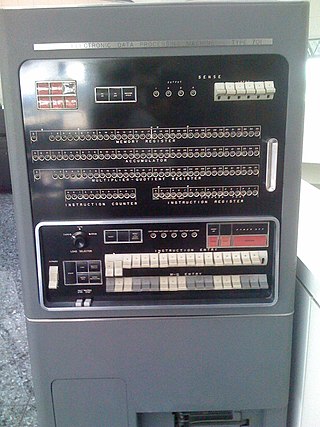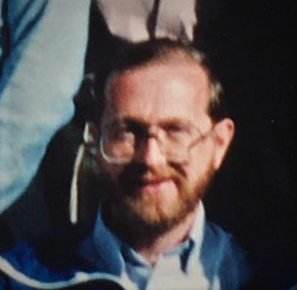Related Research Articles

The IBM System/360 (S/360) is a family of mainframe computer systems that was announced by IBM on April 7, 1964, and delivered between 1965 and 1978. It was the first family of computers designed to cover both commercial and scientific applications and a complete range of applications from small to large. The design distinguished between architecture and implementation, allowing IBM to release a suite of compatible designs at different prices. All but the only partially compatible Model 44 and the most expensive systems use microcode to implement the instruction set, featuring 8-bit byte addressing and fixed point binary, fixed point decimal and hexadecimal floating-point calculations.

Magnetic-core memory is a form of random-access computer memory. It predominated for roughly 20 years between 1955 and 1975, and is often just called core memory, or, informally, core.
A stored-program computer is a computer that stores program instructions in electronically or optically accessible memory. This contrasts with systems that stored the program instructions with plugboards or similar mechanisms.

The IBM 701 Electronic Data Processing Machine, known as the Defense Calculator while in development, was IBM’s first commercial scientific computer and its first series production mainframe computer, which was announced to the public on May 21, 1952. It was designed and developed by Jerrier Haddad and Nathaniel Rochester and was based on the IAS machine at Princeton.

The UNIVAC 1103 or ERA 1103, a successor to the UNIVAC 1101, is a computer system designed by Engineering Research Associates and built by the Remington Rand corporation in October 1953. It was the first computer for which Seymour Cray was credited with design work.

Gerrit Anne "Gerry" Blaauw was a Dutch computer scientist, known as one of the principal designers of the IBM System/360 line of computers, together with Fred Brooks, Gene Amdahl, and others.

The IBM 702 was an early generation tube-based digital computer produced by IBM in the early to mid-1950s. It was the company's response to Remington Rand's UNIVAC, which was the first mainframe computer to use magnetic tapes. As these machines were aimed at the business market, they lacked the leading-edge computational power of the IBM 701 and ERA 1103, which were favored for scientific computing, weather forecasting, the aircraft industry, and the military and intelligence communities.
Alan Field Shugart was an American engineer, entrepreneur and business executive whose career defined the modern computer disk drive industry.
International Business Machines (IBM) is a multinational corporation specializing in computer technology and information technology consulting. Headquartered in Armonk, New York, the company originated from the amalgamation of various enterprises dedicated to automating routine business transactions, notably pioneering punched card-based data tabulating machines and time clocks. In 1911, these entities were unified under the umbrella of the Computing-Tabulating-Recording Company (CTR).

CP-40 was a research precursor to CP-67, which in turn was part of IBM's then-revolutionary CP[-67]/CMS – a virtual machine/virtual memory time-sharing operating system for the IBM System/360 Model 67, and the parent of IBM's VM family. CP-40 ran multiple instances of client operating systems – particularly CMS, the Cambridge Monitor System, built as part of the same effort. Like CP-67, CP-40 and the first version of CMS were developed by IBM's Cambridge Scientific Center (CSC) staff, working closely with MIT researchers at Project MAC and Lincoln Laboratory. CP-40/CMS production use began in January 1967. CP-40 ran on a unique, specially modified IBM System/360 Model 40.

The IBM System/360 Model 67 (S/360-67) was an important IBM mainframe model in the late 1960s. Unlike the rest of the S/360 series, it included features to facilitate time-sharing applications, notably a Dynamic Address Translation unit, the "DAT box", to support virtual memory, 32-bit addressing and the 2846 Channel Controller to allow sharing channels between processors. The S/360-67 was otherwise compatible with the rest of the S/360 series.
This article covers the History of CP/CMS — the historical context in which the IBM time-sharing virtual machine operating system was built.

Transformer read-only storage (TROS) was a type of read-only memory (ROM) used between the mid-1940s to the late 1960s, prior to the common use of semiconductor ROM. TROS consisted of wires fed through and around transformer cores. The wires would register binary digits through inductance and separate wires sensing the change in current.

Computer Usage Company (CUC) (1955–1986), sometimes called Computer Usage Corporation, was the first independent company to market computer software.
The IBM 1009 Data Transmission Unit was an IBM communications controller introduced in 1960. The 1009 used the Synchronous transmit-receive (STR) protocol to transfer data at 150 characters per second (cps) over a single point-to-point dial or leased telephone line. The system was advertised as being able to "link the magnetic core memories of IBM 1401 computers over telephone lines."
Robert Rex Seeber Jr. (1910-1969), an inventor at IBM, co-invented the Selective Sequence Electronic Calculator (SSEC). He was born in Detroit, Michigan, graduated with an A.B. from Harvard University in 1932. He died in La Jolla, California. His primary research contributions were in computer systems design, and associative memories and processors.

The IBM System/360 Model 91 was announced in 1964 as a competitor to the CDC 6600. Functionally, the Model 91 ran like any other large-scale System/360, but the internal organization was the most advanced of the System/360 line, and it was the first IBM computer to support out-of-order instruction execution. It ran OS/360 as its operating system. It was designed to handle high-speed data processing for scientific applications. This included space exploration, theoretical astronomy, sub-atomic physics and global weather forecasting.
John Wilson Haanstra was an American electrical engineer and a computer industry executive. Haanstra was notable for his chairmanship of IBM's SPREAD task force whose work led to the creation of the System/360 product line.

The IBM System/360 Model 85 is a high-end member of the System/360 family of computers, with many advanced features, and was announced in January 1968 and first shipped in December 1969. IBM built only about 30 360/85 systems because of "a recession in progress".

David A. Thompson is an American electrical engineer and inventor with a long career at IBM. He is noted for his many contributions to magnetic recording technology. Thompson was inducted into the National Inventors Hall of Fame for the invention and development of the thin-film inductive head and the magnetoresistive read head. These heads are now ubiquitous in all hard-disk drives and magnetic tape recorders.
References
- 1 2 Oral History: Emerson W. Pugh. Accessed August 5, 2016
- ↑ Pugh, Emerson M.; Pugh, Emerson W. (1970). Principles of Electricity and Magnetism. ISBN 978-0201060140.
- ↑ Building IBM. History of Computing. The MIT Press. January 23, 2009. ISBN 9780262512824.
- ↑ IBM's 360 and Early 370 Systems. The MIT Press. January 2003. ISBN 978-0262517201.